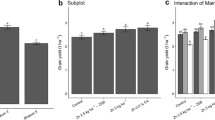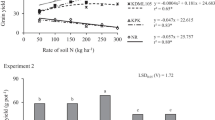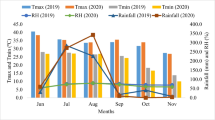Abstract
Background
Increasing zinc (Zn) concentration of rice seed has potential benefits for human nutrition and health. Enhanced levels of Zn in grain also contributes greatly to crop production through better germination and seedling vigor of rice plants grown on soils with limited Zn supply.
Aims and methods
This study evaluated the effect of soil and/or foliar Zn fertilizer application on grain yield and grain Zn concentration of rice grown in 17 field trials conducted in 2008 to 2010 in China, India, Lao PDR, Thailand and Turkey on soils ranging in pH from 4.8 to 8.8 and DTPA- extractable Zn from 0.5 to 6.5 mg kg−1.
Results
Zinc fertilization had little effect on rice grain yield with the exception of increases of up to 10 % in some locations in China and India. As an average of all trials, Zn application increased grain yield by about 5 %. Grain Zn concentrations were, however, more effectively increased by Zn fertilization, especially with foliar Zn applications. On average, Zn concentration in brown rice (whole caryopsis with husk removed) was increased by 25 % and 32 % by foliar and foliar + soil Zn applications, respectively, and only 2.4 % by soil Zn application. The Zn concentration of un-husked rice (whole grain with husk), which was increased by 66 % by foliar Zn, showed a close association with the Zn in brown and white rice, indicating a possible penetration of Zn from the husk into the inner layers of the rice endosperm. Increase in grain Zn concentration by foliar Zn spray was significantly affected by the timing of the foliar application. More distinct increases in grain Zn by foliar Zn application were achieved when Zn was applied after flowering time, e.g., at early milk plus dough stages.
Conclusions
Foliar Zn spray offers a practical and useful means for an effective biofortification of rice grain with Zn. This practice consistently and significantly contributed to increases in grain Zn of rice irrespective of cultivars, environmental conditions and management practices in 5 different countries.




Similar content being viewed by others
References
Black RE, Lindsay HA, Bhutta ZA, Caulfield LE, De Onnis M, Ezzati M, Mathers C, Rivera J (2008) Maternal and child undernutrition: global and regional exposures and health consequences. Lancet 371:243–260
Bouis HE, Welch RM (2010) Biofortification- a sustainable agricultural strategy for reducing micronutrient malnutrition in the global South. Crop Sci 50:20–32
Cakmak I (2008) Enrichment of cereal grains with zinc: agronomic or genetic biofortification? Plant Soil 302:1–17
Cakmak I, Kalayci M, Kaya Y, Torun AA, Aydin N, Wang Y, Arisoy Z, Erdem H, Gokmen O, Ozturk L, Horst WJ (2010) Biofortification and localization of zinc in wheat grain. J Agric Food Chem 58:9092–9102
Fang Y, Wang L, Xin Z, Zhao L, An X, Hu Q (2008) Effect of foliar application of zinc, selenium, and iron fertilizers on nutrients concentration and yield of rice grain in China. J Agric Food Chem 56:2079–2084
Gibson RS, Manger MS, Krittaphol W, Pongcharoen T, Gowachirapant S, Bailey KB, Winichagoon P (2007) Does zinc deficiency play a role in stunting among primary school children in NE Thailand? Br J Nutr 97:167–175
Gomez-Becerra HF, Abugalieva A, Morgounov A, Abdullayev K, Bekenova L, Yessimbekova M, Sereda G, Shpigun S, Tsygankov V, Zelenskiy Y, Pena RJ, Cakmak I (2010a) Phenotypic correlations, G x E interactions and broad sense heritability analysis of grain and flour quality characteristics in high latitude spring bread wheats from Kazakhstan and Siberia. Euphytica 171:23–38
Gomez-Becerra HF, Yazici A, Ozturk L, Budak H, Peleg Z, Morgounov A, Fahima T, Saranga Y, Cakmak I (2010b) Genetic variation and environmental stability of grain mineral nutrient concentrations in Triticum dicoccoides under five environments. Euphytica 171:39–52
Graham RD, Senadhira D, Beebe S, Iglesias C, Monasterio I (1999) Breeding for micronutrient density in edible portions of staple food crops: conventional approaches. Field Crop Res 60:57–80
Hotz C, Brown KH (2004) Assessment of the risk of zinc deficiency in populations and options for its control. Food Nutr Bull 25:94–204
Kutman UB, Yildiz B, Cakmak I (2011a) Improved nitrogen status enhances zinc and iron concentrations both in the whole grain and the endosperm fraction of wheat. J Cereal Sci 53:118–125
Kutman UB, Yildiz B, Cakmak I (2011b) Effect of nitrogen on uptake, remobilization, and partitioning of zinc and iron throughout the development of durum wheat. Plant Soil 342:149–164
Lee S, Jeon US, Lee SJ, Kim YK, Persson DP, Husted S, Schjoerring JK, Kakei Y, Masuda H, Nishizawa NK, An G (2009) Iron fortification of rice through activation of the nicotianamine synthase gene. Proc Natl Acad Sci U S A 106:22014–22019
Lott JNA, Spitzer E (1980) X-ray analysis studies of elements stored in protein body globoid crystals of Triticum grains. Plant Physiol 66:494–499
Morgounov A, Gomez-Becerra HF, Abugalieva A, Dzhunusova D, Yessimbekova M, Muminjanov H, Zelenskiy Y, Ozturk L, Cakmak I (2006) Iron and zinc grain density in common wheat grown in Central Asia. Euphytica 155:193–203
Peck AW, McDonald GK, Graham RD (2008) Zinc nutrition influences the protein composition of flour in bread wheat (Triticum aestivum L.). J Cereal Sci 47:266–274
Persson DP, Hansen TH, Laursen KH, Schjoerring JK, Husted S (2009) Simultaneous iron, zinc, sulfur and phosphorus speciation analysis of barley grain tissues using SEC-ICP-MS and IP-ICP-MS. Metallomics 1:418–426
Pfeiffer WH, McClafferty B (2007) Biofortification: breeding micronutrient-dense crops. In: Kang MS, Priyadarshan PM (eds) Breeding major food staples. Blackwell Science, New York, pp 61–91
Prom-u-thai C, Huang L, Rerkasem B, Thomson G, Kuo J, Saunders M, Dell B (2008) The distribution of protein bodies and phytate rich inclusions in grain tissues in relation to iron density in low and high Fe rice genotypes. Cereal Chem 85:257–265
Randhawa NS, Sinha MK, Takkar PN (1978) Micronutrients. In: Soils and rice, International Rice Research Institute, pp. 581–603
Rengel Z, Graham RD (1995) Importance of seed zinc content for wheat growth on zinc deficient soil. I. vegetative growth. Plant Soil 173:259–266
Sims JT, Johnson GV (1991) Micronutrient soil tests. In: Mortvedt JJ, Cox FR, Shuman LM, Welch RM (eds) Micronutrients in agriculture: second edition. Soil Science Society of America Book Series. Soil Science Society of America, Inc, Madison, pp 427–476
Slaton NA, Wilson CE Jr, Ntamatungiro S, Norman RJ, Boothe DL (2001) Evaluation of zinc seed treatments for rice. Agron J 93:157–163
Slaton NA, Norman RJ, Wilson CE Jr (2005) Effect of zinc source and application time on zinc uptake and grain yield of flood-irrigated rice. Agron J 97:272–278
Stein AJ, Nestel P, Meenakshi JV, Waim M, Sachdev HPS, Bhutta ZA (2007) Plant breeding to control zinc deficiency in India: how cost-effective is biofortification? Publ Health Nutr 10:492–501
Welch RM, Graham RD (2004) Breeding crops for enhanced micronutrient content. Plant Soil 245:205–214
Wissuwa M, Ismail AM, Graham RD (2008) Rice grain zinc concentrations as affected by genotype, native soil-zinc availability, and zinc fertilization. Plant Soil 306:37–48
Yilmaz A, Ekiz H, Torun B, Gültekin I, Karanlik S, Bagci SA, Cakmak I (1998) Effect of different zinc application methods on grain yield and zinc concentration in wheat grown on zinc-deficient calcareous soils in Central Anatolia. J Plant Nutr 20:461–471
Zhang YQ, Shi RL, Karim MR, Zhang FS, Zou CQ (2010) Iron and zinc concentrations in grain and flour of winter wheat as affected by foliar application. J Agric Food Chem 58:12268–12274
Zhao FJ, Su YH, Dunham SJ, Rakszegi M, Bedo Z, McGrath SP, Shewry PR (2009) Variation in mineral micronutrient concentrations in grain of wheat lines of diverse origin. J Cereal Sci 49:290–295
Acknowledgments
This study was financially supported by the HarvestPlus Program (www.harvestplus.org) and the sponsors of the HarvestPlus Global Zinc Fertilizer Project-I. Phase (www.harvestzinc.org) including Mosaic Company, K + S Kali GmbH, International Zinc Association, Omex Agrifluids, International Fertilizer Industry Association and International Plant Nutrition Institute.
Author information
Authors and Affiliations
Corresponding author
Additional information
Responsible Editor: Hans Lambers.
Rights and permissions
About this article
Cite this article
Phattarakul, N., Rerkasem, B., Li, L.J. et al. Biofortification of rice grain with zinc through zinc fertilization in different countries. Plant Soil 361, 131–141 (2012). https://doi.org/10.1007/s11104-012-1211-x
Received:
Accepted:
Published:
Issue Date:
DOI: https://doi.org/10.1007/s11104-012-1211-x




